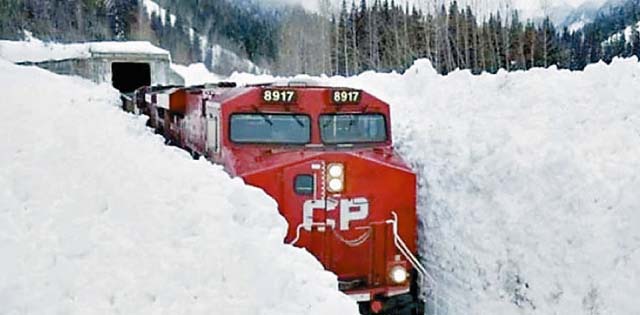|
General Electric model ES44AC built in 2011 leads train CP8917West as it exits the Mount Mcdonald tunnel - Date unknown
Anonymous Photographer.
12 December 2014
Trains Can't be Built for Winter
Says Expert
North America - Harsh winter is a fact of life in Western Canada, but farmers shouldn't hold their breath waiting for winter-optimized
grain trains, says a former railway vice-president.
Not only would winter-best trains likely be worse for the rest of the year, but railway manufacturers aren't too interested in customizing equipment for the
Prairies.
"You've got that wintertime effect on 40 percent of the network for 8, 10, 12 weeks, but you want hard, wear-resistant rail across the entire network for
12 months of the year," said Paul Miller, who is now "railroader-in-residence" at the University of Alberta.
"You've got to find that balance."
It might seem like a no-brainer for Canada's rail lines, hopper cars, and locomotives to be designed to deal with temperatures that fall below -25 C a few
times each winter.
It's a sentiment that farmers, grain companies, and exporters often express when rail transportation begins having major problems when those conditions
appear.
However, Miller said that the grain industry is one of the toughest rail-reliant industries for which to achieve rail optimization.
Unlike potash, coal, and sulfur, which can operate regular shipments throughout the year, grain shipments ebb and flow through the year on both sides of the
Canada-U.S. border.
It means that specially designated trains, in which rail cars and locomotives are kept together permanently, virtually don't exist in the grain
industry.
Even in the United States, where shuttle trains of dedicated locomotives and cars operate regularly in the grain industry, they run that way only for a few
months at a time.
Then the locomotives and cars are broken up and sent to places that have more demand for them.
As a result, locomotive and car owners need equipment that is interchangeable across the North American network, which means it can't be easily
customized.
For example, Miller said air brakes begin to work poorly at below -25 C.
Electronically controlled pneumatic (ECP) brakes are an excellent replacement, but they can't be installed in locomotives and hoppers that will later need to
be mixed with non-ECP trains.
"Any constraint you put on translates very quickly to a reduction in capacity," said Miller.
The same goes for the steel wheels on which cars and locomotives rely.
Anything that makes them tougher in the deepest cold is likely to work worse during the rest of the year.
Even if Canadian railways wanted to optimize their rail lines, locomotives, and cars for winter, they might not be able to buy any.
North America has only two locomotive manufacturers and few car builders, and they produce standard vehicles for all conditions.
They probably aren't interested in producing customized machines for specific conditions.
That means Western Canada's grain industry, which includes the railways, must rely on steady incremental improvements in performance rather than breakthrough
inventions that could dramatically improve the system.
Ed White.
|


